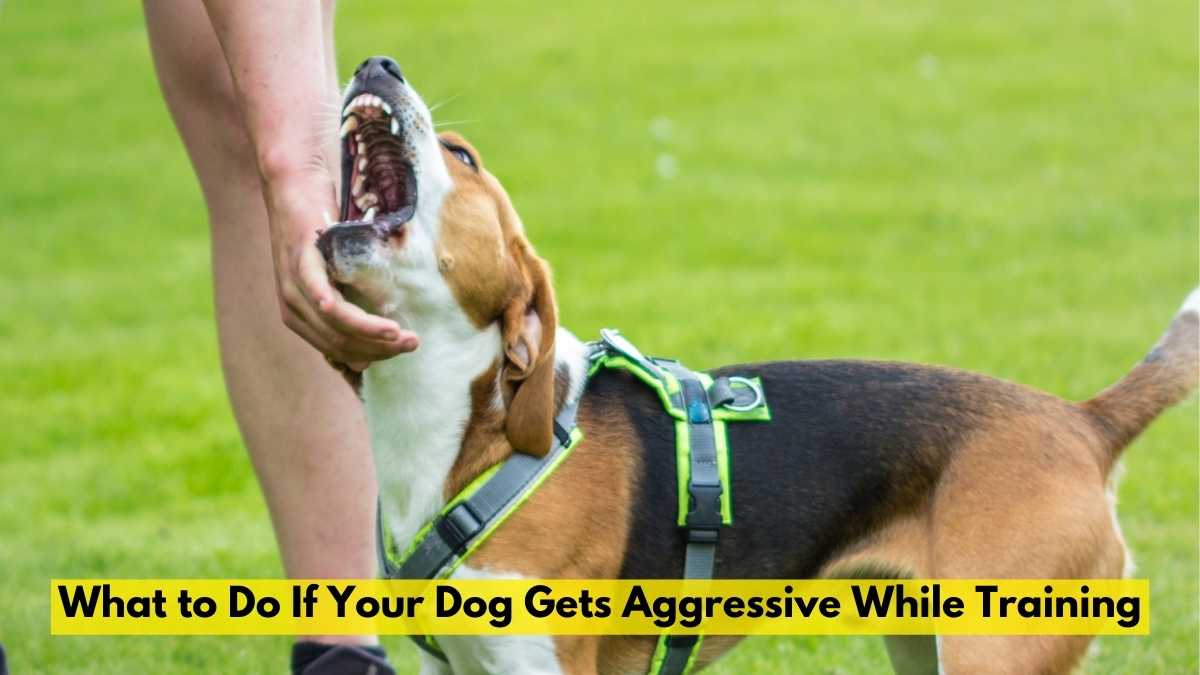Training your dog is an essential part of responsible pet ownership. However, sometimes dogs may exhibit signs of aggression during training, which can be concerning and challenging for both the pet owner and the dog. Understanding how to handle aggression during training is crucial to ensure the safety of everyone involved and to foster a positive learning experience for your furry companion. In this article, we will explore effective strategies to manage and address aggression during training sessions, emphasizing positive reinforcement techniques and professional guidance.
Table of Contents
1. Stay Calm and Safe
When your dog displays signs of aggression during training, it’s essential to remain calm and composed. Reacting with panic or fear may escalate the situation further. Instead, take a deep breath and focus on maintaining your own safety. Aggressive behavior can be unpredictable, so create distance between you and your dog by stepping back slowly. Avoid direct eye contact, as this can be perceived as a challenge by your dog. Remember that staying calm helps de-escalate the situation and prevents the dog from feeling threatened.
2. Identify the Triggers
Understanding what triggers your dog’s aggressive behavior is crucial for effective training. Observe your dog during various training exercises and take note of specific situations, actions, or stimuli that provoke aggression. Triggers can vary from dog to dog and may include factors such as certain commands, loud noises, unfamiliar people, or even other animals. Identifying the triggers allows you to make necessary adjustments to the training environment and avoid potentially aggressive situations in the future.
3. Consult a Professional
Dealing with aggression requires specialized knowledge and experience. Seeking advice from a professional dog trainer or a certified animal behaviorist is highly recommended. These experts can accurately assess your dog’s behavior, determine the underlying causes of aggression, and develop a customized training plan that addresses the specific needs of your dog. Their expertise will ensure that you approach the issue in a safe and effective manner, improving the chances of positive results.
4. Use Positive Reinforcement
Positive reinforcement is a powerful training technique that focuses on rewarding desired behaviors rather than punishing undesirable ones. When working with an aggressive dog, it is essential to emphasize positive reinforcement methods. Offer treats, toys, or verbal praise when your dog displays good behavior, follows commands, or responds appropriately during training. This approach helps build a positive association with training and encourages your dog to continue displaying desired actions.
5. Establish Clear Boundaries
Setting clear rules and boundaries during training sessions is crucial for an aggressive dog. Consistency is key to reinforcing these boundaries and preventing confusion. Use clear, firm commands and reward your dog when they follow instructions appropriately. This establishes a sense of structure and leadership, making your dog feel more secure during training sessions.
6. Avoid Physical Punishment
Physical punishment or intimidation should never be used as a training method, especially for aggressive dogs. Such approaches can worsen aggressive behavior, erode trust, and damage the bond between you and your dog. Instead, focus on positive reinforcement and other force-free training techniques that encourage cooperation and respect.
7. Manage the Environment
Controlling the training environment is essential when dealing with an aggressive dog. Gradually expose your dog to challenging situations, ensuring they feel comfortable and confident. Avoid overwhelming them with too many stimuli at once, and always keep safety in mind. If you identify specific triggers, create a controlled setting where you can gradually introduce the trigger while providing positive reinforcement for calm behavior.
8. Implement Desensitization and Counterconditioning
Desensitization and counterconditioning are powerful behavior modification techniques used to reduce a dog’s negative emotional response to triggers. Gradually expose your dog to the triggers in a controlled manner, pairing them with positive experiences, such as treats and praise. Over time, this process helps your dog develop a more positive association with the triggers, reducing their aggressive responses.
9. Consider Muzzle Training
If your dog’s aggression poses a risk to other people or animals, consider muzzle training. A properly fitted muzzle can prevent bites while you work on training and behavior modification. Muzzle training should always be done positively, associating the muzzle with positive experiences, to ensure your dog remains comfortable while wearing it.
10. Keep Training Sessions Short and Positive
Aggressive dogs may become stressed or overwhelmed during training sessions if they are too long or intense. Keep the training sessions brief and positive to avoid pushing your dog past their limits. End each session on a positive note, even if it’s just a simple command executed successfully. This reinforces positive associations with training and encourages your dog to look forward to future sessions.
11. Monitor Progress and Adjust Training
Behavior modification takes time, and progress may be gradual. Regularly assess your dog’s progress during training and make adjustments as needed. Keep track of the triggers and situations that have shown improvement, as well as those that still need attention. Be patient and persistent in your training efforts, and celebrate even small victories along the way.
Conclusion
Dealing with an aggressive dog during training requires a thoughtful and patient approach. Staying calm and safe, understanding the triggers, seeking professional guidance, and emphasizing positive reinforcement are key components of effective training. Setting clear boundaries, avoiding physical punishment, and managing the training environment further enhance the chances of success.
Implementing desensitization and counterconditioning techniques and considering muzzle training when necessary can also contribute to a safer and more positive training experience. By keeping training sessions short and positive and continually monitoring progress, you can work towards creating a harmonious and respectful relationship with your dog, built on trust and understanding. Remember that each dog is unique, so tailor your training approach to suit your dog’s individual needs and personality for the best results.
You May Also Like:
Norwegian Dog Commands for Your Furry Friend
Is Your Dog Jumping Up on People: Effective Training Tips and Techniques To Stop Your Dog


1 thought on “What to Do If Your Dog Gets Aggressive While Training”